How to: Use the Multi Lift Opportunities Report
Your company likely measures it's crane productivity - it's one of the most important KPI's for a busy terminal. But could your cranes be more efficient? Or could your stowage planning process be improved? BAPLIE Viewer Online's Multi Lift Opportunities Report will calculate the possible number of twin, tandem, triplet and quad moves that could have taken place during vessel discharge and load operations. Use this information to benchmark your existing productivity and help to make better operational decisions.
This feature is available for all membership types.
After logging into BAPLIE Viewer Online, upload both the Inbound BAPLIE file to use for evaluating discharge moves, and the Outbound BAPLIE file to use for evaluating load moves. Open the Inbound BAPLIE file for viewing and click 2D Bay View from the side menu.
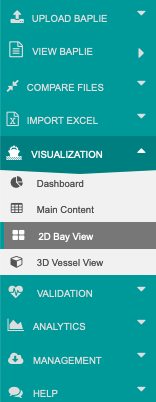
The first time you (or anyone from your facility) uses this feature, you’ll have to set the parameters to use for calculations. Once this has been submitted, it will be saved against your facility information so anyone else from your facility can use this feature with the settings you submitted. Anyone who changes these parameters will also update across the facility. If you need to change these at any time, you can do so by clicking “Change Calculation Parameters”.

How to set the calculation parameters:
UN LOC Code – set this to your port. The system automatically pulls a list of unique POD and POL values from the file for you to select from.
The next group are all Container Types to mark as Eligible for Multi-lift operation. Toggle the Yes/No selections accordingly.
- Tanks
- Platforms
- Open Tops
- Reefers
- Flat Racks
- OOG
The next group are based on the capabilities of your Quay Cranes:
- Dual Spreaders
- Triplets Capable – if you do not have dual spreaders this option is disabled. If your equipment or TOS is not capable of handling Triplets (two 20’ containers and a single 40’ container), set this parameter to No.
The next group are Maximum Weight restrictions, defined in Metric Tonnes
- Max Weight for Quads
- Max Weight for Twins
- Max Weight Difference for Twins
The next value is for Maximum Height Difference for containers on the same spreader, defined in Centimeters
Once you have selected all your various parameters, press “Calculate”
Navigating the Multi Lift Report:
On the left hand side is Statistics, Container Moves, Multi Lift Percentage and Unable to lift Reasons.
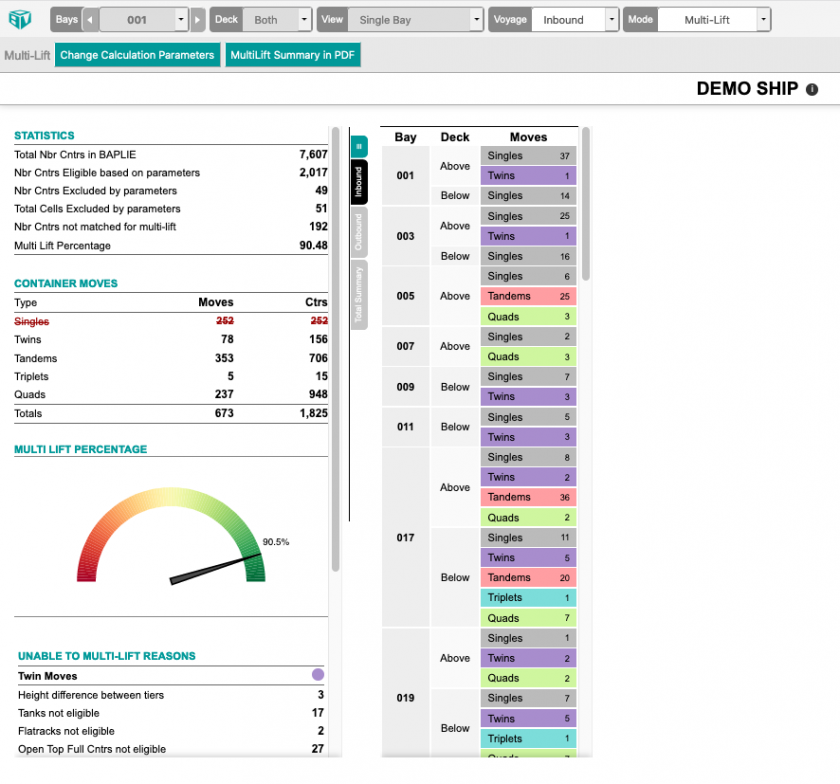
Statistics –
- Total number of containers in the BAPLIE file
- Number of containers eligible to be considered for multi lift based on the parameters selected
- Number of containers excluded from consideration by multi lift based on the parameters selected
- Total cells excluded – this is the number of Twenty Foot Slots excluded based on the parameters selected
- Number of containers not matched by multi lift – a container that is eligible for Multi Lift but could not be matched with another eligible container based on the crane parameters set.
Container Moves –
- Total number of containers and Moves by type. Single Moves do not count towards the total move count and total container count.
Multi Lift Percentage –
- visually represents the percentage of containers that can be handled by MultiLift
Unable to Multi Lift Reasons –
- this shows the top reasons for why containers were not considered based on the parameters you selected. This can be container type eligibility or crane/spreader limitations.
Also off to the left hand side is 3 navigation tabs: Inbound, Outbound and Total Summary.
You can toggle between the Inbound and Outbound voyage. To do so, you’ll need to define the File to use as the Outbound Voyage by using the top navigation bar to change Voyage dropdown to Outbound.

Any files previously uploaded that have the same vessel name will appear. Select the outbound voyage file and press continue.

You will then be able to seamlessly switch between the two files without having to reload the page, as well as see the total summary of the Multi Lift evaluation for both the inbound and outbound voyage.
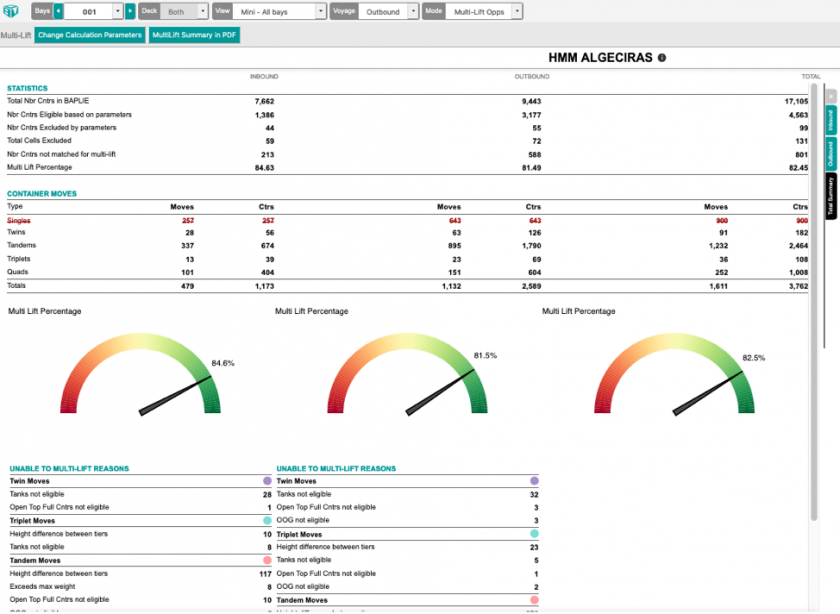
If you wish to hide this side tab, click the menu button to minimize it.

Next, you’ll see the summary of eligible moves by Bay, Deck and Move Type.
These are colored by:
- Grey for Singles (ineligible for Multi Lift)
- Purple for Twins
- Pink for Tandems
- Blue for Triplets
- Green for Quads
Clicking on a Move Type will display a 2D Mini View of the bay you’ve selected, with the containers colored by move type.
You will also see the container numbers by that Move Type, their position and ISO code.

When you hover over the container numbers, they will be highlighted in the 2D Mini View and the other containers will be greyed out.
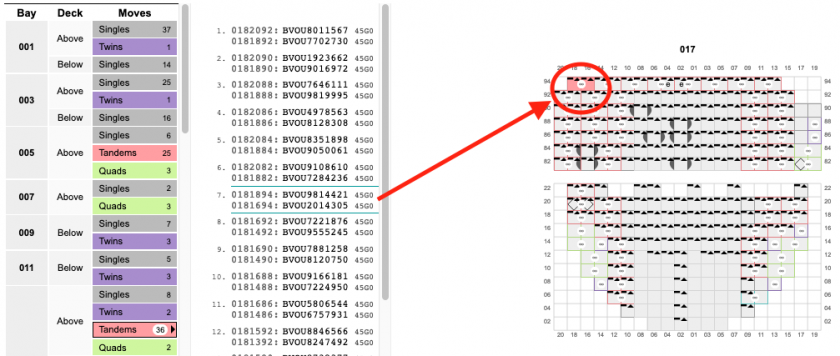
When you click on a container number, the Container Info Pop Up will be displayed with all the relevant container information.

Alternatively when you hover over a container in the 2D View, it will also be highlighted on the container list.
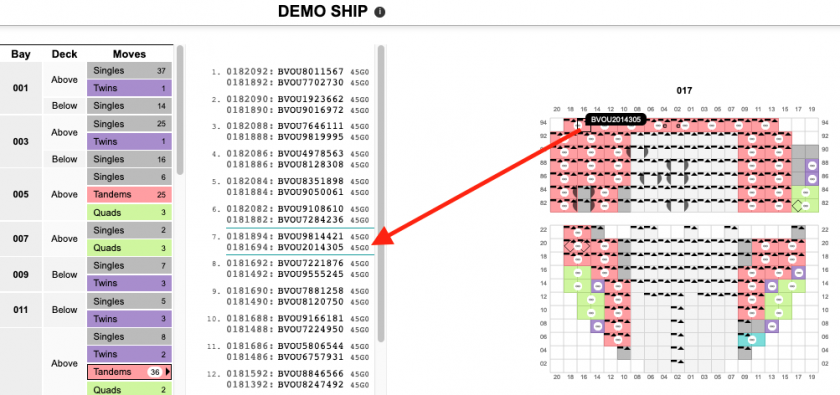
Visualize Multi Lift Report in 2D View
To better visualize all of the multi lift containers in the entire vessel, switch Mode using any of the View styles such as “Mini - All Bays” and use the Color By: feature. Once you have evaluated MultiLift one time for the file you are viewing, this functionality becomes available.
- Change the Mode dropdown from Multi Lift to View

- Select the View method you wish to use such as Mini - All Bays

- Change the “Color By” to Multi Lift Type
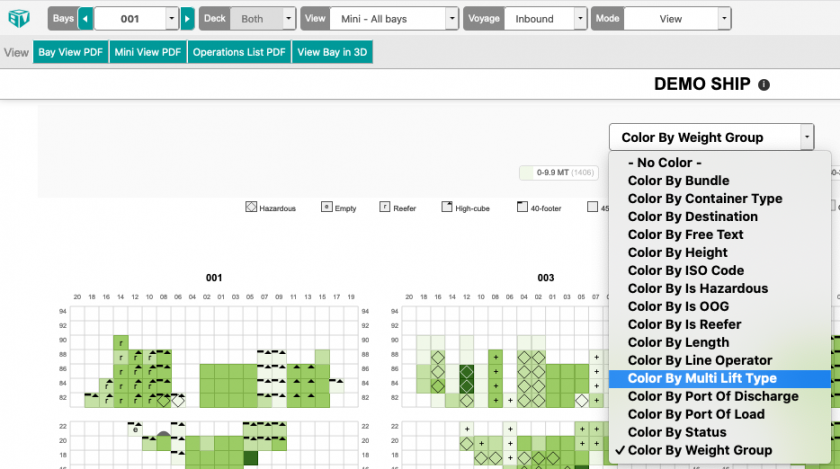
- The same colors in the Multi Lift Report are in the Mini View - Grey for Singles (ineligible for Multi Lift), Purple for Twins, Pink for Tandems, Blue for Triplets, and Green for Quads.
- You will also see a link symbol between two containers to represent the moves that are grouped together
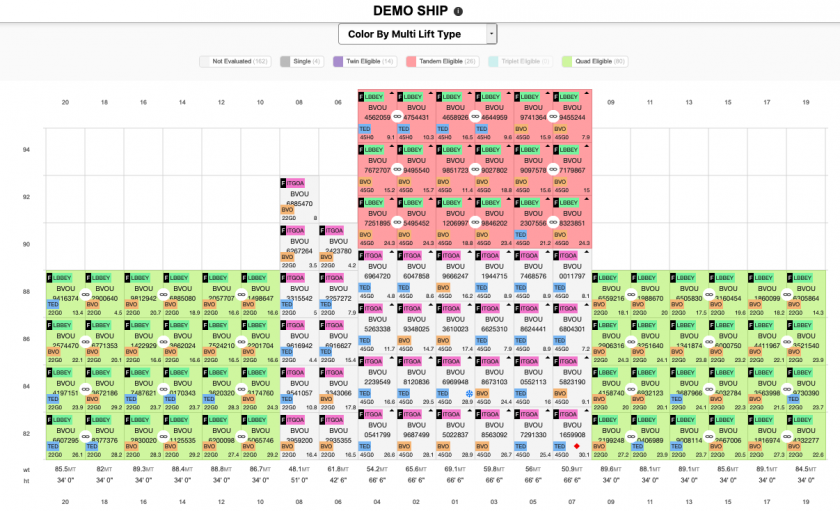
Printing Options for Multi Lift Report
BAPLIE Viewer Online also allows you to share and print this report by saving the Multi Lift Summary to PDF format. This option is found on the top navigation bar.

The PDF shows all of the details of the ship and voyage as well as same reports found within BAPLIE Viewer Online. If you have evaluated only the Inbound, only that information will be shown, but if you’ve evaluated the Outbound file as well than both and the total will be shown.


